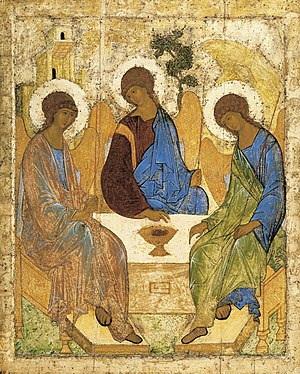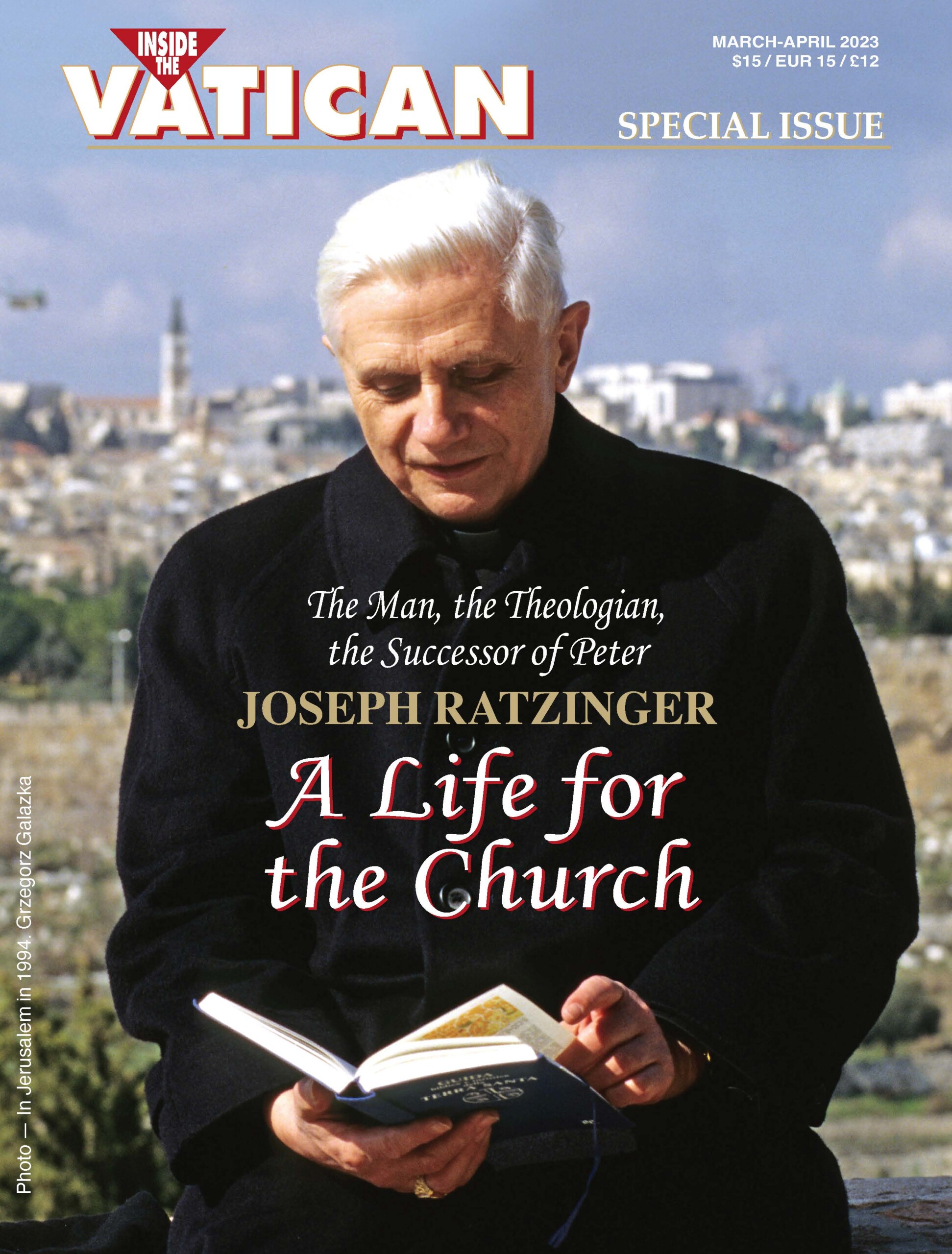![]()
Andrei Rublev‘s room in the Tretyakov Gallery in Moscow, Russia. Up until now, it has housed the famous Trinity icon, dating from 1425, almost 700 years ago. (Photo Credit: By Shakko (Софья Багдасарова) — Own work, CC BY-SA 4.0, link)
Letter #94, 2023 Wednesday, May 17: The Trinity
A famous Russian icon is changing hands from the Russian state to the Russian Orthodox Church.
The decision is Vladimir Putin‘s, president of the Russian state.
The Moscow Patriarchate said in a statement Monday that Putin made the decision to hand over the icon “in response to numerous requests from Orthodox believers.”
The icon, dated to 1425, was originally intended only for the Church, and was for centuries in the possession of the Russian Orthodox Church, and deeply venerated by Christians in the country.
Then, after the 1917 Bolshevik revolution, the icon came into the possession of the declaredly atheist Soviet state, and it has remained in the possession of the state authority in Russia, in a museum, from that time until today.
So, symbolically, the handover could seem to represent a certain change in the relationship between Church and state in Russia.
Removing a famous and revered icon from a state museum after nearly a century, and returning it into the hands of a Church which suffered decades of persecution and infiltration by state security agents, could suggest at least the beginning of a change between the state authority in Russia and the Church authority.
But whether this act signifies any actual change in the state’s attitude toward religion, and religious faith, in present-day Russia, or is rather merely a calculated “public relations” move in a politically difficult time for the present regime, due to the war in Ukraine and its corollary effects, must be for more qualified observers to judge.
Here we merely note this decision, and propose that it may have some significance for the life of Russia.
The Trinity icon represents the three persons of the Holy Trinity in the symbolic images of three angels.
“The Trinity depicts the three angels who visited Abraham at the Oak of Mamre (Genesis 18:1–8), but the painting is full of symbolism and is interpreted as an icon of the Holy Trinity. At the time of Rublev, the Holy Trinity was the embodiment of spiritual unity, peace, harmony, mutual love, and humility.” (link)
Below is a Tass report on the matter from yesterday, May 16:
Tass, 16 MAY, 07:34
Kremlin highlights importance of Holy Trinity icon’s handover to Russian Orthodox Church (link)
The icon’s handover was cleared with Russian President Vladimir Putin
MOSCOW, May 16. /TASS/. The decision to hand Andrey Rublev’s icon of the Holy Trinity over to the Russian Orthodox Church stemmed primarily from the fact that the relic holds great significance for a large number of Russian believers, Kremlin Spokesman Dmitry Peskov told reporters on Tuesday [May 16].
“Naturally, it’s mostly about humanitarian considerations in the sense that there are a large number of believers in our country who view [the icon] as a sacred object,” he explained.
The icon’s handover was cleared with Russian President Vladimir Putin, Peskov said. “As for documents and paperwork, that’s the responsibility of the Ministry of Culture,” he noted when asked how the move had been formalized. “Definitely, it was agreed with the head of state,” the Kremlin spokesman added.
In response to a question about whether Putin had held consultations with the cultural intelligentsia, Peskov said: “Of course, such decisions aren’t made without consulting the relevant experts.” Peskov also said that he was unaware if the authorities were considering the possibility of handing over more Christian relics to the Russian Orthodox Church.
The Moscow Patriarchate reported on its website on Monday that Andrey Rublev’s Holy Trinity icon had been returned to the Russian Orthodox Church. It will be displayed for veneration at Moscow’s Christ the Savior Cathedral for a year before returning to the place it used to occupy in the Trinity Cathedral at the Trinity Lavra of St. Sergius outside Moscow. Metropolitan Tikhon (Shevkunov) of Pskov and Porkhov, chairman of the Patriarch’s Council on Culture, told TASS that the icon would be housed in compliance with the Tretyakov Gallery’s requirements.
[End, Tass report]
Below is a second report on this matter, from the Moscow Times.—RM

Putin Hands Over Historic Icon to Church (link)
The Moscow Times
May 16, 2023
Russian President Vladimir Putin has handed over the country’s most acclaimed Russian icon — Andrei Rublev‘s Trinity — to the Church, the Moscow Patriarchate said on Monday [that is, on May 15].
The handover of Rublev’s most famous work to the Russian Orthodox Church comes after its hugely powerful head Patriarch Kirill threw his support behind Putin’s decision to send troops to Ukraine and urged believers to support the offensive.
The Moscow Patriarchate said in a statement that Putin made the decision to hand over the icon “in response to numerous requests from Orthodox believers.”
The masterpiece is believed to have been painted for what is now the Trinity Lavra of St. Sergius located in the town of Sergiyev Posad outside Moscow.
After the 1917 Bolshevik revolution, the icon was transferred to the Tretyakov Gallery in 1929.
It left the museum only several times including during World War II when it was evacuated to safety.
In 2022, the medieval icon traveled back to the Trinity Lavra of St. Sergius for religious celebrations.
The move was criticized by art experts who said the work of art should be kept at the Tretyakov Gallery where it can be properly preserved.
The Moscow Patriarchate said the icon will be exhibited for a year at the Christ the Savior Cathedral in Moscow before returning to the historic monastery in Sergiyev Posad.
On Sunday, the Hermitage Museum said another Russian monastery will receive the memorial complex of the tomb of Alexander Nevsky, a medieval prince and national hero.
An agreement lending the tomb for 49 years with possibility of extension was signed between the Hermitage Museum and the Church, with approval from the Culture Ministry.
Handing the prince’s tomb to the Alexander Nevsky Monastery of the Holy Trinity will be a sign of “particular social and spiritual unity,” the museum said in a statement.
Following military setbacks for Russia in Ukraine, authorities in Moscow have sought to depict the military campaign in religious terms. Dozens of Orthodox priests have been sent to the front to support Russian troops.
In a sermon last September, Patriarch Kirill said dying in Ukraine “washes away all sins.”
[End, Moscow Times report on the handing over of the Trinity icon to the Russian Orthodox Church.]







Facebook Comments